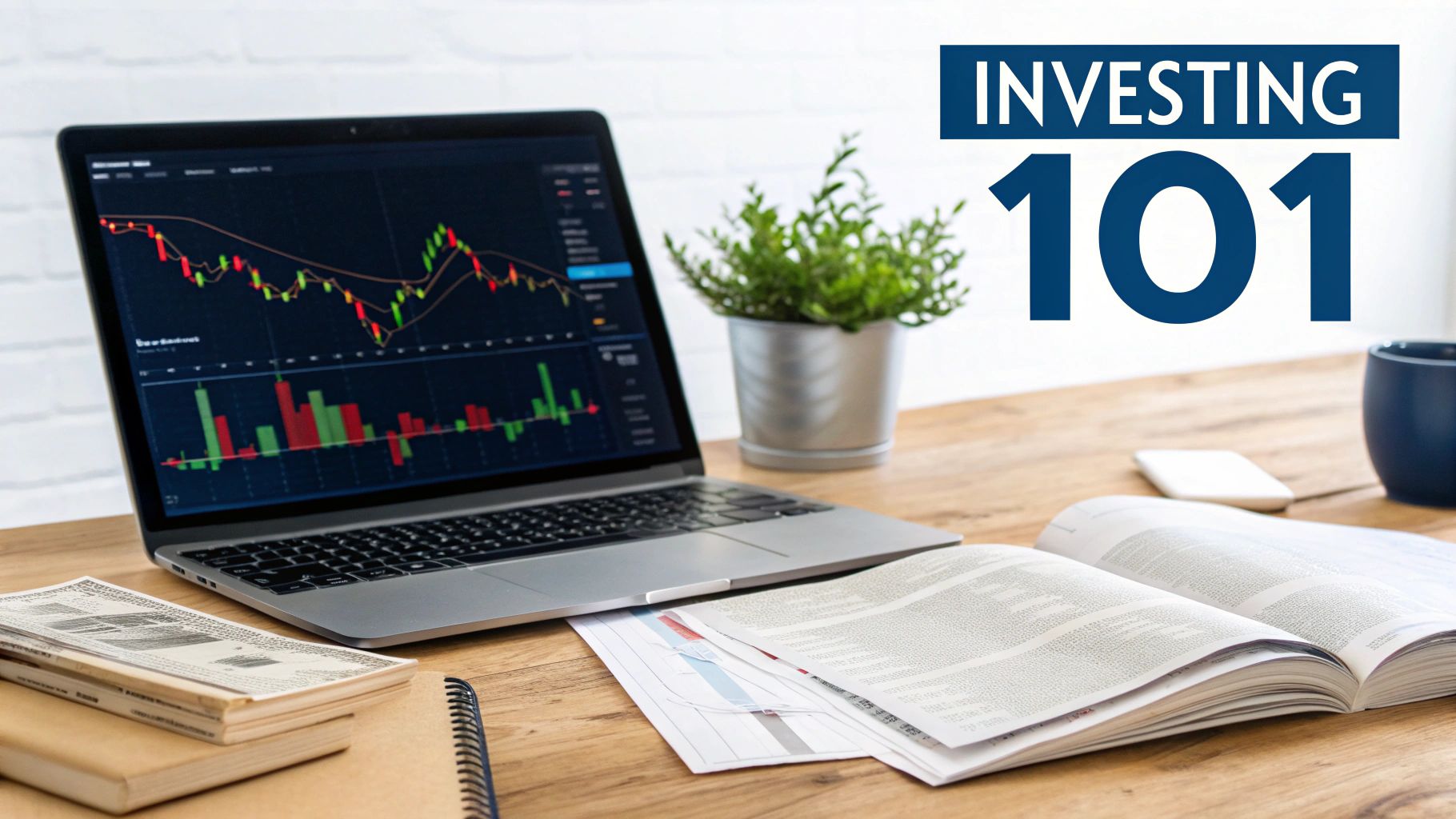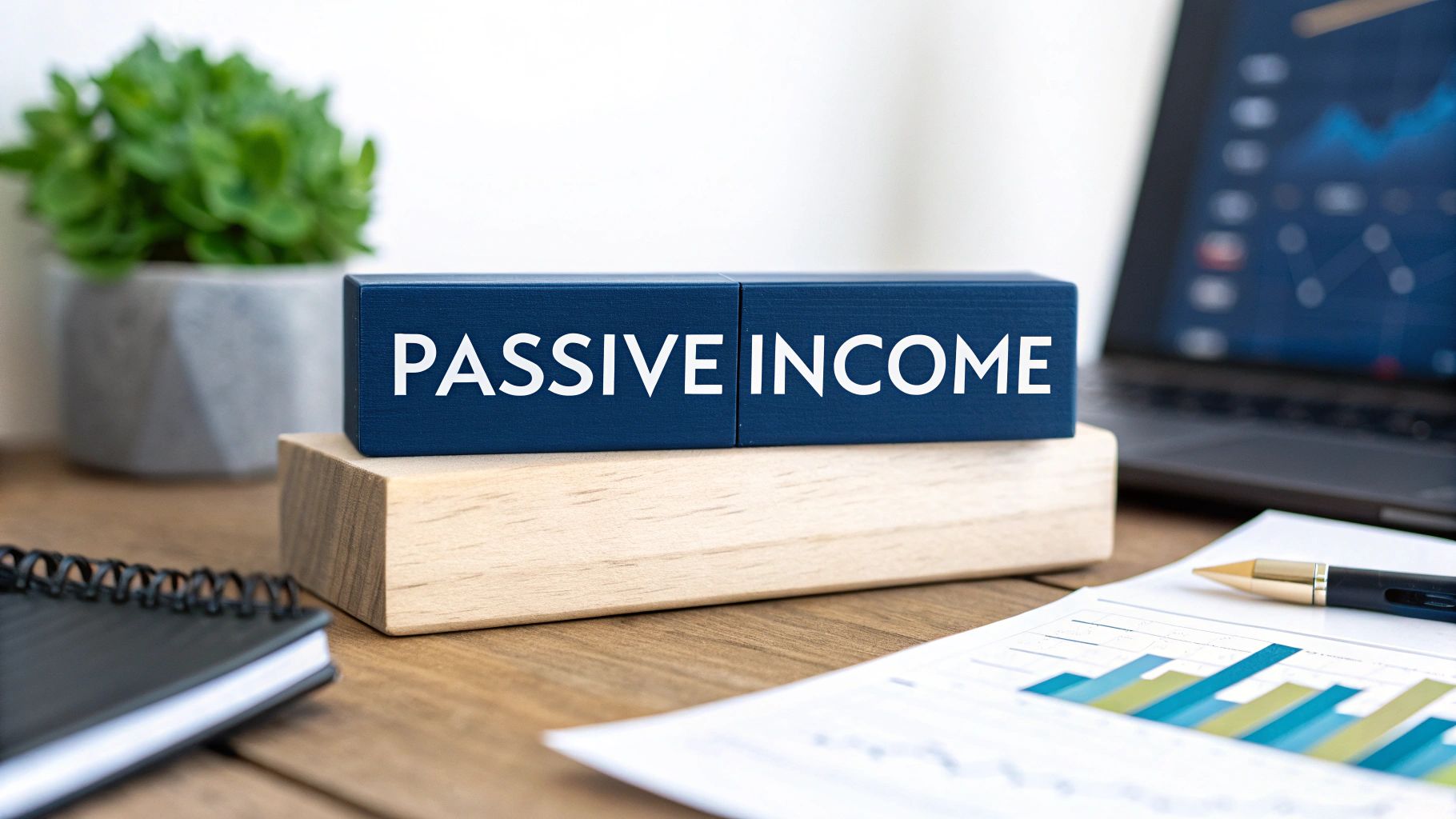Understanding The Power of Dividend Investing

Dividend investing is all about sharing in a company's profits. Instead of just waiting for a stock's price to go up, dividend investors get regular payments just for owning the stock. This makes dividend investing appealing to beginners looking for both income and long-term growth. This consistent income can be particularly helpful when the market is turbulent, acting as a buffer against price swings. This added stability is a major reason many see dividend investing as a core element of a balanced financial plan.
How Dividends Work
Companies share a portion of their profits with shareholders as dividends. These payouts typically come as cash dividends, which are deposited right into your brokerage account. Companies can also issue stock dividends, giving you more shares of the company. Less common are special dividends, larger, one-time payments often tied to strong company performance or the sale of assets. Knowing the different types of dividends helps you make smart choices about your investments.
Why Dividend Investing Matters For Beginners
Dividend investing offers some significant perks for those new to investing. It’s an accessible path to building wealth gradually. Even starting small, investments can grow significantly over time thanks to the power of compounding, where your reinvested dividends earn their own dividends. Plus, the reliable income from dividends can be reassuring during market dips, encouraging a long-term view. This can be especially helpful for new investors who might be tempted to make impulsive decisions based on short-term market fluctuations.
Dividend Yield: A Key Metric
For newcomers, understanding dividend yield is essential. Dividend yield is calculated by dividing the annual dividend per share by the stock's current price. So, a stock paying $4 in annual dividends with a price of $100 has a 4% dividend yield. The average dividend yield for S&P 500 companies historically sits between 1% and 3%, varying with market conditions. Very high yields, like those above 8%, can be a red flag, possibly signaling financial problems within the company. New investors should look for stocks with reasonable yields and a history of steady dividend growth. Investopedia is a great resource to learn more about dividend investing. Remember, dividend yield isn't the only factor. A company's financial health and dividend payout ratio are also important for a successful dividend investing strategy. A thorough understanding of the companies you invest in is key to getting the best returns.
Essential Metrics That Reveal Winning Dividend Stocks
Looking for reliable dividend stocks? It's more than just chasing high yields. Beginner investors need to understand the key metrics that indicate a company's financial health and the sustainability of its dividends. These insights can help you avoid "yield traps"—stocks with tempting yields that might crumble under pressure. By understanding these metrics, you'll be empowered to build a robust dividend portfolio.
Dividend Payout Ratio: A Measure of Sustainability
The dividend payout ratio is a cornerstone of dividend stock analysis. This ratio shows the percentage of a company's earnings distributed as dividends. A healthy range is typically below 60%. This suggests the company retains enough earnings to reinvest in growth and withstand economic downturns. For instance, a company earning $1 per share and paying a $0.50 dividend has a 50% payout ratio. High payout ratios can be a red flag, as they signal potential difficulty maintaining payments if earnings decline. Prioritize companies with stable payout ratios for consistent dividend income. Learn more about dividend investing on YouTube.
Dividend Growth Rate: Aiming for Consistent Increases
While current yield is important, don't overlook the dividend growth rate. This metric tracks how a company increases its dividend payments over time. Consistent growth can outperform a high starting yield in the long term, reflecting a company’s commitment to shareholders and its ability to generate growing profits. Seek companies with a solid history of steadily increasing dividends. This consistent growth, coupled with dividend reinvestment, can significantly boost your returns over time.
Earnings Per Share (EPS) Growth: Fueling Future Dividends
Earnings per share (EPS) is a fundamental indicator of a company's profitability. Strong and consistent EPS growth is crucial for supporting future dividend increases. After all, a company can only sustain growing dividend payouts if its earnings are also on the rise. Review a company's EPS growth over several years to evaluate its capacity to fund future dividends. Healthy EPS growth is the bedrock of reliable and increasing dividend income.
Debt-to-Equity Ratio: Gauging Financial Stability
The debt-to-equity ratio measures a company's financial leverage. A high ratio indicates heavy reliance on debt, potentially straining its ability to pay dividends, especially during economic hardship. A lower ratio generally signifies greater financial stability, reducing the risk of dividend cuts and reinforcing the reliability of your dividend income.
Return on Equity (ROE): Evaluating Profitability
Return on equity (ROE) reveals how effectively a company utilizes shareholder investments to generate profit. A higher ROE generally points to better management and efficient capital use. This efficiency increases the likelihood of sustained and growing dividend payments. Look for companies demonstrating consistently high ROE as a hallmark of strong financial performance.
To help you evaluate these metrics, let's look at a comparison table:
Essential Dividend Stock Metrics
A comparison of key metrics beginners should evaluate when selecting dividend stocks
| Metric | What It Shows | Healthy Range | Warning Signs |
|---|---|---|---|
| Dividend Payout Ratio | Percentage of earnings paid as dividends | Below 60% | Above 80% - may be unsustainable |
| Dividend Growth Rate | Rate of dividend increase over time | Consistent positive growth | Stagnant or declining growth |
| Earnings Per Share (EPS) Growth | Company's profitability | Steady positive growth | Declining or erratic growth |
| Debt-to-Equity Ratio | Company's financial leverage | Low to moderate | High ratio indicates heavy debt burden |
| Return on Equity (ROE) | How efficiently a company uses shareholder investments | Consistently high | Low or declining ROE |
This table summarizes the crucial metrics for evaluating dividend stocks. By considering these factors, you can gain a comprehensive understanding of a company's financial health and dividend sustainability.
By analyzing these key metrics, beginners can navigate the world of dividend investing with greater confidence, identifying companies poised for long-term, sustainable income. These metrics provide a powerful framework for selecting winning dividend stocks and building a robust portfolio.
Crafting Your First Dividend Portfolio That Actually Works

Now that you understand the key metrics for evaluating dividend stocks, let's talk about how to build your first dividend portfolio. This section offers a practical guide to get you started on the right foot. With a structured approach, you can gain the confidence to invest wisely.
Setting Your Foundation: Budget, Targets, and Timeline
Before diving into the market, take some time to assess your financial situation. Figure out your initial investment budget, whether it's a lump sum or recurring contributions. Then, set realistic income targets. Building a substantial dividend income stream takes time, so start small and gradually increase your investments.
Finally, establish a personalized investment timeline. Are you a long-term investor focused on growth, or are you looking for income within a specific timeframe? Your timeline will heavily influence your investment strategy.
Diversification: Spreading Your Investments
Diversification is essential for managing risk in any investment portfolio. Spreading your investments across various industries and company sizes safeguards your capital. Think of it like this: you wouldn't put all your eggs in one basket. Similarly, avoid concentrating all your investments in a single stock or sector.
Consider a mix of established blue-chip companies and smaller, high-growth businesses. This balanced approach can help cushion your portfolio from significant losses if one area underperforms.
ETFs vs. Individual Stocks: Starting with Simplicity
For beginners, dividend ETFs (exchange-traded funds) offer a straightforward entry point into dividend investing. ETFs provide instant diversification by holding a basket of dividend-paying stocks. This simplifies the initial investment process and mitigates risk compared to picking individual stocks.
As you become more experienced, you can gradually incorporate individual stocks into your portfolio, tailoring it to your specific goals and risk tolerance.
Where to Invest: Beginner-Friendly Platforms
Selecting the right brokerage platform can make a big difference in your investing journey. Look for platforms that offer commission-free trading, especially if you're focusing on ETFs. Many user-friendly platforms like Fidelity and Schwab provide research tools and educational resources tailored for beginners, simplifying the process of getting started.
Position Sizing and Contribution Frequency: Building Momentum
Position sizing, or determining how much to invest in each holding, is a crucial aspect of portfolio management. A good rule of thumb is to limit any single holding to a small percentage of your total portfolio. This helps manage risk by reducing your exposure to the performance of any one investment.
Establish a regular contribution frequency – whether it's monthly, quarterly, or annually – to build momentum. Consistent contributions, even small ones, can significantly accelerate your progress toward your dividend investing goals.
As your portfolio grows, remember to rebalance periodically. This involves adjusting your holdings to maintain your desired asset allocation, ensuring your investments stay aligned with your risk tolerance and income goals. With a well-defined strategy and consistent effort, you can build a successful dividend portfolio that generates passive income over time. Patience and consistency are key to long-term success in dividend investing.
Accelerating Wealth Through Dividend Reinvestment

Dividend reinvestment is a powerful tool that can significantly boost your investment returns. By automatically reinvesting your dividends, you're essentially using your profits to buy more shares. This creates a snowball effect, accelerating your wealth accumulation over time. This section explores how dividend reinvestment plans (DRIPs) work and why they're a valuable strategy, especially for those just starting their investment journey.
The Power of Compounding: How DRIPs Work
Dividend Reinvestment Plans (DRIPs) allow you to automatically reinvest dividend payments back into the stock that issued them. This creates compound growth, where your reinvested dividends generate their own dividends. Over time, this compounding effect can dramatically increase your returns. A small initial investment, combined with consistent reinvestment, can grow significantly larger compared to simply taking dividends as cash. This potential for exponential growth makes DRIPs a highly effective strategy.
DRIP vs. Cash Dividends: A Real-World Comparison
Let's look at a hypothetical example to illustrate the impact of dividend reinvestment. The following table compares the growth of a $10,000 initial investment with dividends reinvested versus taken as cash over various time periods. We'll assume a 4% annual dividend yield and 5% annual stock price appreciation.
To understand the long-term impact of reinvesting dividends, let's examine a hypothetical scenario.
The table below, "DRIP vs. Cash Dividend Comparison," shows the growth comparison of a $10,000 initial investment with dividends reinvested versus dividends taken as cash over different time periods. This comparison assumes a 4% annual dividend yield and a 5% annual stock price appreciation.
| Time Period | Initial Investment | With DRIP | Cash Dividends Only | Difference |
|---|---|---|---|---|
| 5 Years | $10,000 | $12,763 | $12,155 | $608 |
| 10 Years | $10,000 | $16,700 | $14,802 | $1,898 |
| 20 Years | $10,000 | $29,778 | $21,911 | $7,867 |
| 30 Years | $10,000 | $53,066 | $33,004 | $20,062 |
As you can see, the difference between reinvesting and taking cash dividends grows significantly over time. The longer your investment horizon, the more pronounced the benefits of compounding become.
Types of DRIPs: Company-Sponsored vs. Broker-Sponsored
There are two primary types of DRIPs: company-sponsored DRIPs and broker-sponsored DRIPs. Company-sponsored plans are administered directly by the company issuing the stock. These plans sometimes offer the opportunity to purchase additional shares at a discount. However, they may require paperwork and sometimes involve administrative fees.
Broker-sponsored DRIPs are managed through your brokerage account. These offer the convenience of automatic reinvestment and typically don't charge fees. They're a popular choice, particularly for those new to dividend investing. Broker-sponsored plans usually reinvest dividends into fractional shares, allowing you to reinvest even small dividend amounts. However, they generally don't offer the same discounts sometimes available with company-sponsored plans.
Tax Implications and Strategic Timing
It's important to be aware of the tax implications of dividend reinvestment. Reinvested dividends are still considered taxable income in the year they're received, even if you don't receive them as cash. Holding dividend-paying stocks in a tax-advantaged account, such as an IRA, can be a smart way to minimize your tax burden.
As your financial goals change, you might decide to switch from reinvesting dividends to receiving them as cash income. This is a frequent strategy as investors move from a growth-focused phase to an income-focused phase of their investing journey. By understanding how compounding works, choosing the right DRIP for your needs, and being mindful of the tax implications, you can effectively use dividend reinvestment as a powerful tool to build wealth.
Minimizing Taxes to Maximize Your Dividend Returns

Smart tax strategies are key to getting the most out of your dividend investments. This section will help beginners understand how dividends are taxed and how to structure investments for better after-tax returns. Understanding these details can make a big difference in your long-term financial well-being.
Qualified Vs. Non-Qualified Dividends: Understanding the Difference
Dividends are taxed differently depending on their classification as qualified or non-qualified. Qualified dividends are taxed at the lower, long-term capital gains rates. These rates can be 0%, 15%, or 20%, depending on your taxable income. This favorable tax treatment is a big plus for dividend investors.
Non-qualified dividends, however, are taxed as ordinary income. This means they could be taxed at a significantly higher rate. This distinction is crucial for understanding your tax liability and making smart investment decisions. Knowing the difference can substantially impact your overall investment results.
Tax-Advantaged Accounts: Sheltering Your Dividend Income
One of the best ways to minimize taxes on dividends is to hold dividend-paying stocks in tax-advantaged accounts. These accounts, such as IRAs, Roth IRAs, and 401(k)s, offer significant tax benefits that can boost your long-term investment returns.
In a traditional IRA, your dividend income grows tax-deferred. You won't pay taxes on it until retirement when you withdraw the money. This allows for more compounding and greater potential for wealth accumulation. Roth IRAs offer tax-free withdrawals in retirement, but contributions are made with after-tax dollars. Understanding these accounts is essential for maximizing your dividend income.
Strategic Asset Location: Optimizing Your Holdings
Strategic asset location involves strategically choosing where to hold different investments. For beginner dividend investors, this means deciding which dividend stocks to hold in taxable accounts and which to hold in retirement accounts.
It's often beneficial to hold high-yielding dividend stocks in tax-advantaged accounts. This shields the income from current taxes. Lower-yielding stocks, or those with strong growth potential, can be held in taxable accounts. This strategic placement of assets can significantly improve your overall tax efficiency and maximize your after-tax returns.
Navigating International Dividend Taxation
Investing in international dividend stocks introduces another layer of complexity to tax planning. Many foreign countries withhold a portion of dividend payments as foreign withholding tax.
You can often claim a credit or deduction on your U.S. tax return to offset this withheld amount. The process can be complex, and consulting with a tax professional may be helpful. Their expertise can help ensure you're maximizing returns and staying compliant with tax laws. Don't let these complexities deter you from exploring the benefits of international dividend investing.
By understanding these tax strategies, new dividend investors can make well-informed choices to minimize taxes and maximize investment growth. As your portfolio expands, these tax-efficient methods become even more important for protecting and growing your wealth.
Avoiding the Costly Mistakes That Derail Dividend Investors
Dividend investing offers a compelling path to financial freedom, but it’s important to be aware of potential pitfalls. Even experienced investors can make mistakes that impact their returns. This section explores some common missteps and offers strategies to help you avoid them.
The High-Yield Trap: Chasing Unsustainable Dividends
One of the most common mistakes is chasing exceptionally high dividend yields. While a high yield can be tempting, it can sometimes indicate underlying financial problems within a company. A company struggling with declining earnings might maintain a high dividend to attract investors, creating a yield trap.
This unsustainable practice often leads to dividend cuts, impacting your income stream and potentially causing capital losses as other investors sell their shares. Instead, focus on companies with sustainable payout ratios, ideally below 60%. This indicates they can comfortably afford their dividend payments. This conservative approach protects your investment and supports steady dividend income over time.
Diversification Neglect: Overexposure to Specific Sectors
Another common pitfall is inadequate diversification. Concentrating your investments in just a few sectors increases your portfolio's vulnerability to sector-specific downturns. For example, imagine most of your dividend investments are in the energy sector during a period of falling oil prices. Your income and portfolio value could suffer.
Diversify across sectors to mitigate this risk. Broadening your holdings across different industries creates a buffer, protecting your portfolio from substantial losses if one sector underperforms.
Emotional Investing: Panic Selling During Market Downturns
Market downturns are inevitable. However, panic selling during these periods can be a costly mistake. Dividend stocks often become more valuable during downturns, offering attractive yields at discounted prices.
Instead of reacting to fear, consider downturns as opportunities. This is a great time to buy more shares of high-quality dividend payers. A disciplined approach can improve your long-term returns. Staying focused on your long-term goals can prevent emotional decisions that could negatively affect your financial well-being.
Overlooking Dividend Growth: Focusing Only on Current Yield
While current yield is an important factor, don't focus on it exclusively. A company with a lower current yield but a strong track record of dividend growth can often outperform a high-yielding counterpart over time. Dividend growth indicates a company's ability to consistently increase profits and share that success with shareholders.
Look for companies with a history of consistently raising their dividends, ideally at a rate exceeding inflation. This growth, combined with the power of compounding, can lead to significant wealth accumulation over the long term.
Ignoring Company Fundamentals: Neglecting Financial Health
Never overlook the financial health of a company. A high dividend yield is unsustainable if the company is struggling financially. Carefully analyze a company's financial statements, including its earnings per share (EPS), debt-to-equity ratio, and return on equity (ROE). These metrics provide valuable insights into the company's profitability, financial stability, and ability to generate future dividends.
By understanding and avoiding these common mistakes, you can significantly improve your chances of success with dividend investing. Building a successful dividend portfolio requires planning, monitoring, and a commitment to a long-term strategy.
Are you ready to take your understanding of financial freedom and dividend investing to the next level? The Covered Call Podcast explores the strategies and inspiring stories of individuals who have achieved financial independence through unconventional paths. Featuring insights from successful entrepreneurs and investors like Luke Gromen, Rick Rule, and Doug Casey, The Covered Call offers actionable advice and real-world examples to help you unlock your financial potential. Learn more and listen to The Covered Call Podcast

